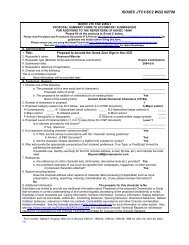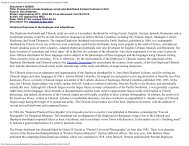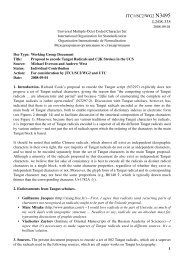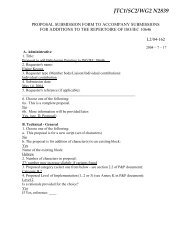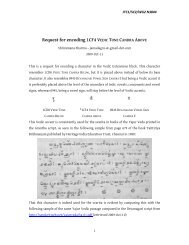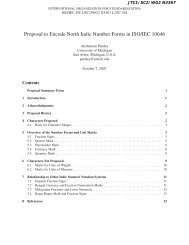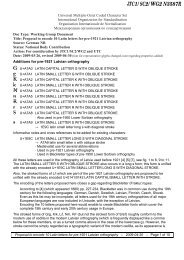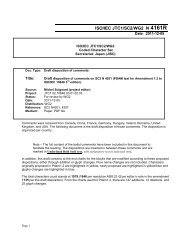Proposal to encode Latin Capital Letter Sharp S - FTP Directory ...
Proposal to encode Latin Capital Letter Sharp S - FTP Directory ...
Proposal to encode Latin Capital Letter Sharp S - FTP Directory ...
Create successful ePaper yourself
Turn your PDF publications into a flip-book with our unique Google optimized e-Paper software.
DIN NIA-01-29-01CODED CHARACTER SETS ISO/IEC JTC1/SC2/WG2N3227<br />
Universal Multiple-Octet Coded Character Set<br />
Universeller mehrfach-8-bit-kodierter Zeichensatz<br />
International Standards Organisation<br />
Internationale Standardisierungsorganisation<br />
Organisation Internationale de Normalisation<br />
Mewdunarodnaå organjsazjå po ctandardjsazjj<br />
Doc. type: Working group document<br />
Titel: <strong>Proposal</strong> <strong>to</strong> <strong>encode</strong> <strong>Latin</strong> <strong>Capital</strong> <strong>Letter</strong> <strong>Sharp</strong> S <strong>to</strong> the UCS<br />
Source: Deutsches Institut für Normung (DIN),<br />
Technical Committee NIA-01-29-01 Coded Character Sets<br />
Status: O⁄cial ISO NB Member Request<br />
Date: 2007-03-21<br />
This proposal requests the encoding of the <strong>Latin</strong> uppercase letter <strong>Sharp</strong> S in ISO/IEC 10646.<br />
The German Institute for Standardization (DIN) has noted the existence of this character in<br />
German print publications and has identified a need for endcoding the <strong>Latin</strong> uppercase letter <strong>Sharp</strong> S<br />
in ISO/IEC 10646. We regard the incorporation of the character in ISO/IEC 10646 as neccessary.<br />
Uppercase <strong>Sharp</strong> S is <strong>to</strong> be seen as the typographical equivalent <strong>to</strong> LATIN SMALL LETTER<br />
SHARP S ( U+00DF).<br />
din nia-01-29-01 sharp-s 2007-03-21<br />
$ LATIN CAPITAL LETTER SHARP S<br />
1/14
ISO/IEC JTC 1/SC 2/WG 2<br />
PROPOSAL SUMMARY FORM TO ACCOMPANY SUBMISSIONS<br />
1<br />
FOR ADDITIONS TO THE REPERTOIRE OF ISO/IEC 10646TP PT<br />
Please fill all the sections A, B and C below.<br />
Please read Principles and Procedures Document (P & P) from HTUhttp://www.dkuug.dk/JTC1/SC2/WG2/docs/principles.html UTH<br />
for guidelines and details before filling this form.<br />
Please ensure you are using the latest Form from HTUhttp://www.dkuug.dk/JTC1/SC2/WG2/docs/summaryform.htmlUTH.<br />
See also HTUhttp://www.dkuug.dk/JTC1/SC2/WG2/docs/roadmaps.html UTH for latest Roadmaps.<br />
A. Administrative<br />
1. Title: <strong>Proposal</strong> <strong>to</strong> <strong>encode</strong> <strong>Latin</strong> <strong>Capital</strong> <strong>Letter</strong> <strong>Sharp</strong> S <strong>to</strong> the UCS<br />
2. Requester's name: Cord Wischhöfer, on behalf of DIN-Committee on Codes Character Sets (NIA-01-29-01)<br />
3. Requester type (Member body/Liaison/Individual contribution): German ISO Member Body<br />
4. Submission date: 2007-03-21<br />
5. Requester's reference (if applicable): E-Mail: cord.wischhoefer@din.de . Fon: +49 (0)30 2601 2535<br />
6. Choose one of the following:<br />
This is a complete proposal: Yes<br />
(or) More information will be provided later:<br />
B. Technical – General<br />
1. Choose one of the following:<br />
a. This proposal is for a new script (set of characters): No<br />
Proposed name of script:<br />
b. The proposal is for addition of character(s) <strong>to</strong> an existing block: Yes<br />
Name of the existing block: <strong>Latin</strong> Extended Additional, <strong>Latin</strong> general use extension<br />
2. Number of characters in proposal: 1<br />
3. Proposed category (select one from below - see section 2.2 of P&P document):<br />
A-Contemporary X B.1-Specialized (small collection) B.2-Specialized (large collection)<br />
C-Major extinct D-Attested extinct E-Minor extinct<br />
F-Archaic Hieroglyphic or Ideographic G-Obscure or questionable usage symbols<br />
4. Is a reper<strong>to</strong>ire including character names provided? Yes<br />
a. If YES, are the names in accordance with the “character naming guidelines”<br />
in Annex L of P&P document? Yes<br />
b. Are the character shapes attached in a legible form suitable for review? Yes<br />
5. Who will provide the appropriate computerized font (ordered preference: True Type, or PostScript format) for<br />
publishing the standard? Andreas Stötzner (as@signographie.de)<br />
If available now, identify source(s) for the font (include address, e-mail, ftp-site, etc.) and indicate the <strong>to</strong>ols<br />
used: Contact as@signographie.de when required<br />
6. References:<br />
a. Are references (<strong>to</strong> other character sets, dictionaries, descriptive texts etc.) provided? Yes<br />
b. Are published examples of use (such as samples from newspapers, magazines, or other sources)<br />
of proposed characters attached? Yes<br />
7. Special encoding issues:<br />
Does the proposal address other aspects of character data processing (if applicable) such as input,<br />
presentation, sorting, searching, indexing, transliteration etc. (if yes please enclose information)? Yes<br />
(see attached)<br />
8. Additional Information:<br />
Submitters are invited <strong>to</strong> provide any additional information about Properties of the proposed Character(s) or Script<br />
that will assist in correct understanding of and correct linguistic processing of the proposed character(s) or script.<br />
Examples of such properties are: Casing information, Numeric information, Currency information, Display behaviour<br />
information such as line breaks, widths etc., Combining behaviour, Spacing behaviour, Directional behaviour, Default<br />
Collation behaviour, relevance in Mark Up contexts, Compatibility equivalence and other Unicode normalization<br />
related information. See the Unicode standard at HTUhttp://www.unicode.orgUTH for such information on other scripts. Also<br />
see HTUhttp://www.unicode.org/Public/UNIDATA/UCD.htmlUTH and associated Unicode Technical Reports for information<br />
needed for consideration by the Unicode Technical Committee for inclusion in the Unicode Standard.<br />
1<br />
TP PT Form number: N3102-F (Original 1994-10-14; Revised 1995-01, 1995-04, 1996-04, 1996-08, 1999-03, 2001-05, 2001-09,<br />
2003-11, 2005-01, 2005-09, 2005-10, 2007-03)
C. Technical - Justification<br />
1. Has this proposal for addition of character(s) been submitted before? Yes<br />
If YES explain A proposal for “<strong>Latin</strong> <strong>Capital</strong> <strong>Letter</strong> Double S” was forwarded <strong>to</strong> the UTC by Andreas<br />
Stötzner in 2004<br />
2. Has contact been made <strong>to</strong> members of the user community (for example: National Body,<br />
user groups of the script or characters, other experts, etc.)? Yes<br />
If YES, with whom? National Body, National Government<br />
If YES, available relevant documents: See attached document<br />
3. Information on the user community for the proposed characters (for example:<br />
size, demographics, information technology use, or publishing use) is included? Yes<br />
Reference:<br />
4. The context of use for the proposed characters (type of use; common or rare) common<br />
Reference:<br />
5. Are the proposed characters in current use by the user community? Yes<br />
If YES, where? Reference: See attached<br />
6. After giving due considerations <strong>to</strong> the principles in the P&P document must the proposed characters be entirely<br />
in the BMP? Yes<br />
If YES, is a rationale provided? No<br />
If YES, reference:<br />
7. Should the proposed characters be kept <strong>to</strong>gether in a contiguous range (rather than being scattered)? No<br />
8. Can any of the proposed characters be considered a presentation form of an existing<br />
character or character sequence? No<br />
If YES, is a rationale for its inclusion provided?<br />
If YES, reference:<br />
9. Can any of the proposed characters be <strong>encode</strong>d using a composed character sequence of either<br />
existing characters or other proposed characters? No<br />
If YES, is a rationale for its inclusion provided?<br />
If YES, reference:<br />
10. Can any of the proposed character(s) be considered <strong>to</strong> be similar (in appearance or function)<br />
<strong>to</strong> an existing character? No<br />
If YES, is a rationale for its inclusion provided?<br />
If YES, reference:<br />
11. Does the proposal include use of combining characters and/or use of composite sequences? No<br />
If YES, is a rationale for such use provided?<br />
If YES, reference:<br />
Is a list of composite sequences and their corresponding glyph images (graphic symbols) provided?<br />
If YES, reference:<br />
12. Does the proposal contain characters with any special properties such as<br />
control function or similar semantics? No<br />
If YES, describe in detail (include attachment if necessary)<br />
13. Does the proposal contain any Ideographic compatibility character(s)? No<br />
If YES, is the equivalent corresponding unified ideographic character(s) identified?<br />
If YES, reference:
Rationale<br />
The character capital sharp S has been existing in printed matters for 128 years. Thus it is a part of<br />
recent German script his<strong>to</strong>ry. Its encoding is required in order <strong>to</strong> match original text lettering in present<br />
editions of old publications. In recent lettering praxis there is a need <strong>to</strong> have the uppercase sharp<br />
S available for some special tasks like branding, shop-signing and book titles.<br />
DIN has thoroughly considered possible consequences of a capital letter sharp S for existing data<br />
s<strong>to</strong>ck and data processing which might be caused by the introduction of the new character. The encoding<br />
of <strong>Capital</strong> <strong>Sharp</strong> S does not interfer with the stability of case folding policy as outlined in doc.<br />
Resolution M47.1, Stability of case folding, doc. N 2954. <strong>Capital</strong> <strong>Sharp</strong> S should be <strong>encode</strong>d<br />
without case folding <strong>to</strong> ß (U+00DF). No corruption of existing data is <strong>to</strong> be expected, user expectations<br />
and orthographical cus<strong>to</strong>ms will not be <strong>to</strong>uched. See the following chapter for a detailed discussion<br />
of these aspects of our proposal.<br />
The frequently used German letter ß (sharp s or “Eszett”) is regularily replaced by “SS” in using<br />
uppercase lettering. Yet, if a word has been written in uppercase letters (e.g. WEISSE), one can not<br />
anymore detect if its proper original spelling is Weiße or Weisse. This being a sensitive matter particularly<br />
with regard <strong>to</strong> personal names, many users see the need for a capital sharp S <strong>to</strong> avoid ambiguity<br />
and confusion. This applies mainly <strong>to</strong> the fields of name writing, company branding and title design.<br />
Because a real capital letter has not been available in coded character set so far, in many instances the<br />
corruption of an uppercase line of characters by a lowercase ß is found. This is obviously an undesirable<br />
makeshift solution, a problem <strong>to</strong> be solved by the encoding of the new character.<br />
Without a sensible solution the present situation constitutes an anomaly German script culture<br />
and an even impediment <strong>to</strong> its further development.<br />
Discussion of technical aspects<br />
(Citations are in cursive writing)<br />
Michael Everson [message <strong>to</strong> as@signographie.de, 23. 10. 2006]:<br />
Because I believe that when it is available, people will want Weiße <strong>to</strong> go <strong>to</strong> WEIßE [WEI$E].<br />
We do not follow that assumption. From our point of view it is important <strong>to</strong> make clear that the<br />
proposition is not aimed at a reformation of the German orthography. The o⁄cial capitalisation of<br />
“ß” remains “SS”. Furthermore it seems imperative <strong>to</strong> make clear that all existing data s<strong>to</strong>ck that uses<br />
“SS” instead of “ß” in German names will remain valid.<br />
We need the capital $ exclusively for the following special purposes:<br />
– <strong>to</strong> retain the distinction between “SS” and “ß” in capital letters in those cases where the owner of<br />
the name wants it (especially in proper names);<br />
– <strong>to</strong> represent text correctly where the capital $ has already been used (his<strong>to</strong>ric text or title-, product-<br />
or company-names, logos etc.).<br />
This does neither exclude the introduction of a capital $ on the basis of a future reform of orthograpy<br />
of the German language with making the “SS” capitalisation an ancient (old-fashioned) variant,<br />
nor the usage of the then available capital $ in future orthographic propositions for higher or lower<br />
German dialects. It is not before such a point in time that we need consider the introduction of new<br />
locales etc.<br />
din nia-01-29-01 sharp-s 2007-03-21<br />
4/14
We propose the following:<br />
The capital $ is considered a special representation of the sequence of letters “SS” (which can be<br />
applied when “SS” is corresponding <strong>to</strong> a “ß”), which is an individual character as opposed <strong>to</strong> a ligature.<br />
It should be discussed if the compatibility decomposition <strong>to</strong> “U+0053 U+0053” should be<br />
assigned <strong>to</strong> the new Unicode character. That would provide for the equivalence of the character<br />
sequences “capital ß” and “SS” in those applications that use the Normalization Form KD or KC for<br />
the detection of sameness of names etc. (see also below regarding the problem of the usage in<br />
domain-names (IDN). It seems not su⁄cient <strong>to</strong> solve the IDN-problem with compatibility decomposition.)<br />
The capital $ may under no circumstances change the case mappings of existing data s<strong>to</strong>ck:<br />
– <strong>to</strong>upper (“ß”) remains “SS”;<br />
– <strong>to</strong>lower (“capital ß”) results in “ß”: there is no rule that <strong>to</strong>upper (<strong>to</strong>lower(X)) must give X again,<br />
and existing data s<strong>to</strong>ck is not aƒected as there is no capital $ yet.<br />
Furthermore the “case foldings” of existing data s<strong>to</strong>ck may not be changed:<br />
According <strong>to</strong> the rules of Unicode 5.0 p.188 (5.18 Case Mappings, Caseless Matching) the following<br />
entry in CaseFolding.txt (http://www.unicode.org/Public/UNIDATA/Casefolding.txt) results<br />
from the above-mentioned <strong>to</strong>upper- and <strong>to</strong>lower-values:<br />
XXX;F;0073 0073;# LATIN CAPITAL LETTER SHARP S<br />
Unicode-“Full case folding (mappings that cause strings <strong>to</strong> grow in length):” (see<br />
CaseFolding.txt): results in string “ss” for each “capital ß” with the above-mentioned <strong>to</strong>upper- and<br />
<strong>to</strong>lower values as well as for each lower letter ß.<br />
Application <strong>to</strong> existing data s<strong>to</strong>ck leave data unconditionally unchanged. Unicode-“simplecase<br />
folding, mappings <strong>to</strong> single characters” (see CaseFolding.txt):<br />
A small letter ß is produced for any capital $ that has the above-mentioned <strong>to</strong>lower-value.<br />
Application <strong>to</strong> existing data s<strong>to</strong>ck leave data unconditionally unchanged.<br />
Microsoft-case-folding (no o⁄cial standard, but mentioned by Asmus Freytag [message <strong>to</strong><br />
as@signographie.de, 4. 5. 2006]): … does not apply e.g. <strong>to</strong> the case folding used in the Windows<br />
operating system. Therein a case folding results in an uppercase letter for reasons of compatibility<br />
with DOS. In that case e.g. Windows could not support the equivalence of a normal ß and a capital<br />
$, because that would mean that all ß would have be assigned <strong>to</strong> the uppercase $.<br />
As not only the OS but also many applications make use of that kind of case folding, that would<br />
also aƒect the interfaces of the programs. Compatibility prohibits oƒ-hand changes therein.<br />
As in UnicodeData.txt for the small letter “ß” (U+00DF) for the property Simple_Uppercase_Mapping<br />
an empty value is registered, the “single capital letter” corresponding <strong>to</strong> the “ß” is<br />
again the small-letter “ß”. Because the existing property is not changed by the method described here<br />
(which under no circumstances can be altered with regard <strong>to</strong> the current stability policies) everything<br />
remains the same. Therefore the application <strong>to</strong> existing data s<strong>to</strong>ck leave data unconditionally unchanged<br />
in this case, <strong>to</strong>o.<br />
The results are anyway incorrect according <strong>to</strong> German orthography rules, which makes the result<br />
in a similar manner acceptable with the existence of a capital $.<br />
din nia-01-29-01 sharp-s 2007-03-21<br />
5/14
Unlike the Unicode-full-case-folding Microsoft-case-folding distinguishes between “ss” and “ß”.<br />
One can create files “Maße.txt” and “MASSE.txt” in the same Windows direc<strong>to</strong>ry (otherwise upperand<br />
lower-case letters are not distinguished in Microsoft-Windows-Filesystems).<br />
For the capital $, a “curious” consequence of the demand that the outcome of a Microsoft-casefolding<br />
for upper- and lowercase letters with same resulting-string-lengths should give the same<br />
result is that it is mapped <strong>to</strong> a small letter “ß” (whereas all other letters become uppercase letters).<br />
This can be accepted, because this kind of folding is relevant for technical purposes only, as e.g. comparison<br />
of filenames.<br />
A result similar <strong>to</strong> the Microsoft-case-folding can be found in many SQL-implementations for<br />
the function UPPER, i.e. for UPPER (‘Maße’) the string “MAßE” is returned. According <strong>to</strong> standard<br />
ISO 9075 this is wrong in any case; the result has <strong>to</strong> comply with the Unicode-full-case-folding.<br />
For correct SQL-implementations surely no problems will come up with the introduction of the<br />
capital $, as the ISO-compliant application of UPPER on “ß” still produces “SS”. Future extensions<br />
of the SQL-standard may provide mechanisms for mapping an “ß” on a capital $, but this needs not<br />
<strong>to</strong> be discussed here and now.<br />
It is important <strong>to</strong> clarify the use of a capital $ in domain-names.<br />
Michael Everson claims – justly in our opinion – unambiguously:<br />
But the UTC has rules (which have <strong>to</strong> do with IDN specifications) and this MUST be taken in<strong>to</strong><br />
account. This is NOT just a matter of typography. It aƒects processing, and must be done with all the<br />
costs and benefits in mind. [message <strong>to</strong> as@signographie.de, 23. 10. 2006]<br />
As is the case with all pairs of uppercase-/lowercase pairs, capital $ and lowercase ß must be equivalent.<br />
Following the IDN-rules, the lowercase ß is equivalent <strong>to</strong> the string “ss”. That implies that a<br />
capital $ in a domain-name is equivalent <strong>to</strong> the string “ss”.<br />
This cannot be concluded directly from the formerly proposed “compatibility decomposition” for<br />
a capital $ (IDN-mechanism, http://<strong>to</strong>ols.ietf.org/html/rfc3490), because the mechanism “nameprep”<br />
first performs the substitution by table (and there are only characters from Unicode 3.2) and<br />
after that applies Normalization Form KC (in reverse sequence the capital $ would have been<br />
mapped <strong>to</strong> “SS” in the first step and <strong>to</strong> “ss” in the second step).<br />
This context requires an update of RFC3454 http://<strong>to</strong>ols.ietf.org/html/rfc3454; without it the<br />
usage of a capital $ would be inadmissible. This RFC has <strong>to</strong> be adapted <strong>to</strong> the Unicode-version containing<br />
the capital $, and there in Table B.2 an entry has <strong>to</strong> be supplemented, as we want <strong>to</strong> point out<br />
(albeit the changes in IDN are carried out by another institution and are not au<strong>to</strong>matically adjusted<br />
after the introduction of a capital $ in Unicode):<br />
xxxx;0073 0073; Case map<br />
(xxxx=Hex-Code of the capital $ in Unicode)<br />
On the other hand it is advantageous that the capital $ is inadmissible in domain names: it means<br />
no trouble from that side.<br />
din nia-01-29-01 sharp-s 2007-03-21<br />
6/14
Proposed codepoint: 1E9C<br />
Block: <strong>Latin</strong> Extended Additional, <strong>Latin</strong> general use extension<br />
din nia-01-29-01 sharp-s 2007-03-21<br />
7/14
References<br />
A number of publications clearly show that the uppercase $ was used in printing. It should be<br />
remembered that the actual letter shapes happen <strong>to</strong> be of quite variable quality, they even might easily<br />
be mistaken for lowercase ß.<br />
Note that in all cases which are documented here the intended capitality of the letter is verified.<br />
1. Regeln für die deutsche Schreibung. Ed. Verein für deutsche Rechtschreibung. Berlin 1879, p. 18;<br />
The very first capital $ in German typographic his<strong>to</strong>ry.<br />
2. Ehmcke, F. H.: Ehmcke-Antiqua. Type specimen<br />
of foundry Schri˝gießerei Flinsch. Frankfurt<br />
(Main) 1909<br />
din nia-01-29-01 sharp-s 2007-03-21<br />
Lowercase letter ß<br />
Uppercase letter $<br />
3. Ehmcke, F. H.: Ehmcke-Antiqua Kursiv. Type<br />
specimen of foundry Schri˝gießerei Flinsch. Frankfurt<br />
(Main) 1910<br />
8/14
Å a<br />
Å<br />
a<br />
Å a<br />
Å a<br />
4. Variuos lead typefaces (1913–1928), each containing<br />
either minuscule and majuscule characters for ß<br />
(source: Signa 9/2006, p. 52).<br />
a<br />
a<br />
Å Lowercase a Uppercase<br />
Å a<br />
Å<br />
Å<br />
din nia-01-29-01 sharp-s 2007-03-21 9/14
5. From various print samples, around 1915; source: Deutsche Bücherei Leipzig<br />
din nia-01-29-01 sharp-s 2007-03-21<br />
6. Schlag nach / Natur. Bibliographisches Institut,<br />
Leipzig 1956 (left, bot<strong>to</strong>m left))<br />
7. Schlag nach / Natur. Bibliographisches Institut,<br />
Leipzig 1963 (bot<strong>to</strong>m)<br />
8. Kleine Enzyklopädie / Natur. Bibliographisches Institut,<br />
Leipzig 1963; p. 139, 157<br />
10/14
9. Der Große Duden. 15th edition, Bibliographisches<br />
Institut, Leipzig 1957 (cover and main title)<br />
10. Der Große Duden. 15th edition, Bibliographisches<br />
Institut, Leipzig 1960, 1964 (cover and main title)<br />
din nia-01-29-01 sharp-s 2007-03-21<br />
11/14
11. Those engraved and handwritten samples show how the capital sharp S is part of typographic culture.<br />
(Pho<strong>to</strong>graphy: A. Stötzner, I. Preuß)<br />
GROßE SOßE wrong (lowercase ß)<br />
GROßE SOßE right (uppercase $)<br />
12. <strong>Capital</strong> sharp S is needed for typesetting of commercial advertisements, packaging and titling.<br />
din nia-01-29-01 sharp-s 2007-03-21 12/14
<strong>Proposal</strong> <strong>to</strong> <strong>encode</strong> <strong>Latin</strong> <strong>Capital</strong> <strong>Letter</strong> <strong>Sharp</strong> S <strong>to</strong> the UCS<br />
CONTENTS<br />
Title . . . . . . . . . . . . . . . . . . . . . . . . . . . 1<br />
<strong>Proposal</strong> Summary Form . . . . . . . . . . . . . . . 2<br />
Rationale . . . . . . . . . . . . . . . . . . . . . . . . 4<br />
Discussion of technical aspects . . . . . . . . . . . . 4<br />
Proposed codepoint . . . . . . . . . . . . . . . . . . 7<br />
References . . . . . . . . . . . . . . . . . . . . . . . 8<br />
<strong>Letter</strong> from Bundesministerium des Inneren . . . . . 13<br />
CREDITS<br />
Contribu<strong>to</strong>rs <strong>to</strong> this document are:<br />
Paul Dettmer, Dr. Hans-Werner Eisermann, Karl Pentzlin, Andreas Stötzner, Cord Wischhöfer<br />
din nia-01-29-01 sharp-s 2007-03-21<br />
14/14



